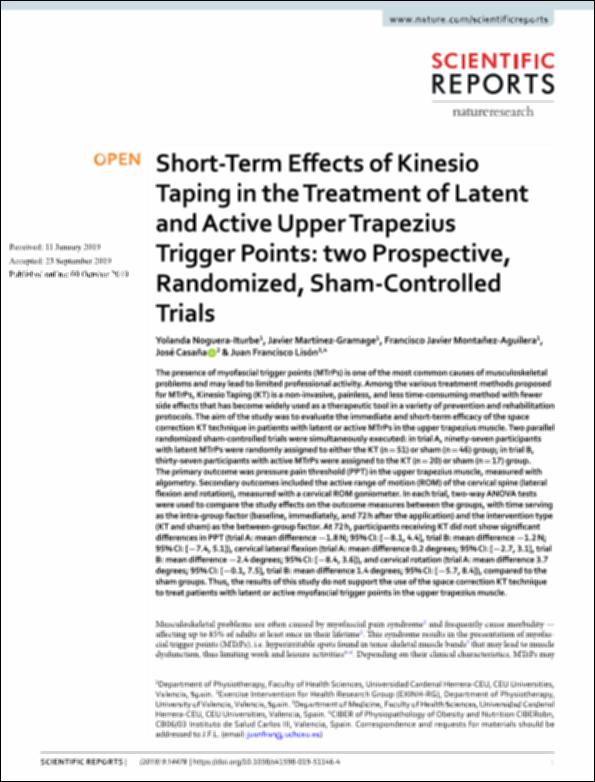Por favor, use este identificador para citar o enlazar este ítem:
http://hdl.handle.net/10637/10901Short-term effects of kinesio taping in the treatment of latent and active upper trapezius trigger points : two prospective, randomized, sham-controlled trials.
| Título : | Short-term effects of kinesio taping in the treatment of latent and active upper trapezius trigger points : two prospective, randomized, sham-controlled trials. |
| Autor : | Noguera Iturbe, Yolanda Martínez Gramage, Javier Montañez Aguilera, Francisco Javier Casaña Granell, José Lisón Párraga, Juan Francisco |
| Materias: | Sistema musculoesquelético - Heridas y lesiones - Tratamiento.; Vendajes - Uso terapéutico.; Bandages and bandaging - Therapeutic use.; Myofascial pain syndromes - Treatment.; Musculoskeletal system - Wounds and injuries - Treatment.; Síndrome de dolor miofascial - Tratamiento. |
| Editorial : | Springer Nature. |
| Citación : | Noguera-Iturbe, Y., Martínez-Gramage, J., Montañez-Aguilera, FJ., Casaña, J. & Lisón, JF. (2019). Short-term effects of kinesio taping in the treatment of latent and active upper trapezius trigger points : two prospective, randomized, sham-controlled trials. Scientific Reports, vol. 9, art. 14478 (9 oct. ). DOI: https://doi.org/10.1038/s41598-019-51146-4 |
| Resumen : | The presence of myofascial trigger points (MTrPs) is one of the most common causes of musculoskeletal problems and may lead to limited professional activity. Among the various treatment methods proposed for MTrPs, Kinesio Taping (KT) is a non-invasive, painless, and less time-consuming method with fewer side efects that has become widely used as a therapeutic tool in a variety of prevention and rehabilitation protocols. The aim of the study was to evaluate the immediate and short-term efcacy of the space correction KT technique in patients with latent or active MTrPs in the upper trapezius muscle. Two parallel randomized sham-controlled trials were simultaneously executed: in trial A, ninety-seven participants with latent MTrPs were randomly assigned to either the KT (n=51) or sham (n=46) group; in trial B, thirty-seven participants with active MTrPs were assigned to the KT (n=20) or sham (n=17) group. The primary outcome was pressure pain threshold (PPT) in the upper trapezius muscle, measured with algometry. Secondary outcomes included the active range of motion (ROM) of the cervical spine (lateral fexion and rotation), measured with a cervical ROM goniometer. In each trial, two-way ANOVA tests were used to compare the study efects on the outcome measures between the groups, with time serving as the intra-group factor (baseline, immediately, and 72h after the application) and the intervention type (KT and sham) as the between-group factor. At 72h, participants receiving KT did not show signifcant diferences in PPT (trial A: mean diference −1.8N; 95% CI: [−8.1, 4.4], trial B: mean diference −1.2N; 95% CI: [−7.4, 5.1]), cervical lateral fexion (trial A: mean diference 0.2 degrees; 95% CI: [−2.7, 3.1], trial B: mean diference −2.4 degrees; 95% CI: [−8.4, 3.6]), and cervical rotation (trial A: mean diference 3.7 degrees; 95% CI: [−0.1, 7.5], trial B: mean diference 1.4 degrees; 95% CI: [−5.7, 8.4]), compared to the sham groups. Thus, the results of this study do not support the use of the space correction KT technique to treat patients with latent or active myofascial trigger points in the upper trapezius muscle. |
| Descripción : | Este es el artículo que se ha publicado de forma definitiva en: https://www.nature.com/articles/s41598-019-51146-4 |
| URI : | http://hdl.handle.net/10637/10901 |
| Derechos: | http://creativecommons.org/licenses/by/4.0/deed.es |
| ISSN : | 2045-2322 (Electrónico). |
| Fecha de publicación : | 9-oct-2019 |
| Centro : | Universidad Cardenal Herrera-CEU |
| Aparece en las colecciones: | Dpto. Enfermería y Fisioterapia |
Los ítems de DSpace están protegidos por copyright, con todos los derechos reservados, a menos que se indique lo contrario.


